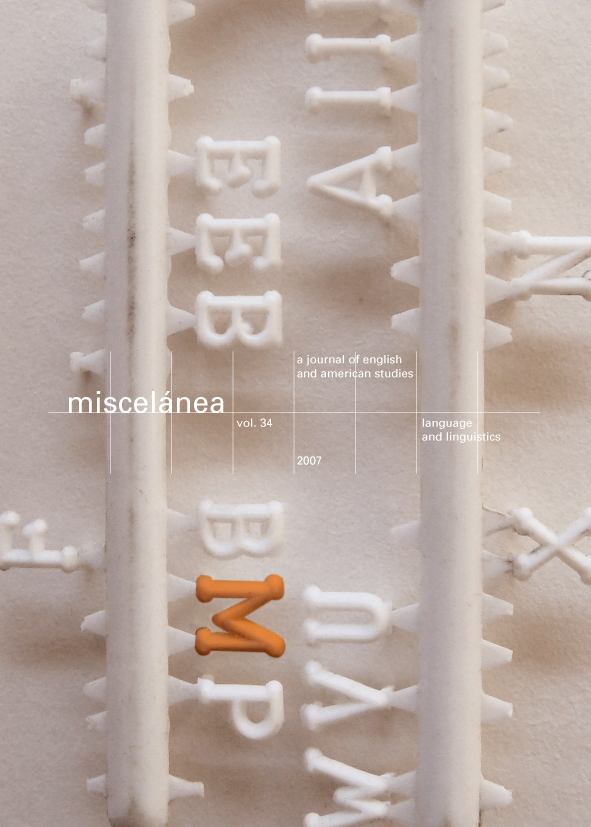Imagining Adam’s Dream: Keats’s Chamber of Maiden Thought in The Eve of St. Agnes
DOI:
https://doi.org/10.26754/ojs_misc/mj.200610105Palabras clave:
Keats, Eve of St. Agnes, Chamber of maiden thought, Personaje poético, Imaginación, G´´eneroResumen
Este artículo pretende explorar la manera en que Keats construye la identidad física y metafísica de Porphyro y Madeline en el poema, así como analizar la relación del género con el proceso artístico, que Keats presenta de forma lírica como una visión del personaje poético esbozado en sus cartas. Basándome en la descripción de Keats del “Sueño de Adán”, el proceso poético, el personaje del poeta, y la chamber of maiden thought de sus cartas, mi tesis es que, en el poema, Porphyro representa el poeta andrógino que cede su identidad masculina a cambio de una femenina —la de Madeline. Aunque Madeline, como musa de Porphyro, responde a los esquemas petrarquistas tradicionales, la doncella muestra al mismo tiempo unos anhelos imaginativos de inspiración divina—, cualidades que se asocian tradicionalmente con el poeta, no con su musa.
Descargas
Referencias
ARSENEAU, Mary. 1997. “Madeline, Mermaids, and Medusas in The Eve of St. Agnes”. Papers on Language and Literature 33 (Summer 1997): 1-9.
BATE, Walter Jackson. 1963. John Keats. Cambridge: Harvard U.P.: 436-457.
—. 1971. “The Winter of 1818-19”. In Allan Danzig. (ed.). Twentieth Century Interpretations of The Eve of St. Agnes. Englewood Cliffs: Prentice Hall: 72-85.
COLVIN, Sidney. 1968. Keats. New York: St. Martin’s: 111-170.
COX Philip. 1995. “Keats and the Performance of Gender”. Keats-Shelley Journal 44: 40-65.
GITTINGS, Robert. 1971. “Rich Antiquity”. In Allan Danzig. (ed.). Twentieth Century Interpretations of The Eve of St. Agnes. Englewood Cliffs: Prentice Hall: 86-98.
GRAY, Erik. 1999. “Indifference and Epistolarity in The Eve of St. Agnes”. Romanticism 5 (2): 1-12.
HOEVELER, Diane Long. 1990. Romantic Androgyny. University Park: Pennsylvania State U.P.: 155-168.
HOLSTEIN, Michael E. 1987. “Keats: The Poet-Healer and the Problem of Pain”. Keats-Shelley Journal 36: 32-49.
KEATS, John. 1999. In John Barnard. (ed.). John Keats Selected Poems. New York: Penguin.
—. 1959. In Douglas Bush. (ed.). Selected Poems and Letters. New York: Houghton.
LEVINSON, Marjorie. 1988. Keats’s Life of Allegory: The Origins of Style. Oxford: Basil Blackwell: 96-190.
MELLOR, Anne K. 1980. English Romantic Irony. Cambridge: Harvard U.P.: 77-108.
—. 2001. “Keats and the Complexities of Gender”. In Susan J. Wolfson. (ed.). The Cambridge Companion to Keats. Cambridge: Cambridge U.P.: 214-229.
MINAHAN, John A. 1992. Word Like a Bell: John Keats, Music and the Romantic Poet. Kent: Kent State U.P.: 70-85.
MOTION, Andrew. 1997. Keats. Chicago: University of Chicago Press.
MURRY, John Middleton. 1955. Keats. New York: Noonday P.: 198-226.
PETERFREUND, Stuart. 1986. “The Truth about ‘Beauty’ and ‘Truth’: Keats’s ‘Ode on a Grecian Urn,’ Milton, Shakespeare, and the Uses of Paradox”. Keats-Shelley Journal 35: 62-82.
RAGUSSIS, Michael. 1975. “Narrative Structure and the Problem of the Divide Reader in The Eve of St. Agnes”. ELH 42 (Fall 1975): 378-394.
ROSENFELD, Nancy. 2000. “‘Eve’s Dream Will Do Here’: Miltonic Dreaming in Keats’s The Eve of St. Agnes”. Keats-Shelley Journal 149: 47-66.
SANDY, Mark. 2000. “Dream Lovers and Tragic Romance: Negative Fictions in Keats’s Lamia, The Eve of St. Agnes, and Isabella”. Romanticism on the Net 20 (Nov 2000).
SHELLEY, Percy Bysshe. 2002. 2nd edition. In Donald H Reiman and Neil Frosart. (eds.). Shelley’s Poetry and Prose. New York: Norton.
SPERRY, Stuart M. 1973. Keats the Poet. Princeton: Princeton U.P.: 198-220.
STEELE, Richard, Joseph Addison. 1969. In Geoffrey Tillotson et al. (eds.). Selections from The Spectator. Eighteenth-Century English Literature. New York: Harcourt: 335-344.
STEVENSON, Warren. 1996. Romanticism and the Androgynous Sublime. London: Associated U.P.: 116-128.
STILLINGER, Jack. 1999. Reading The Eve of St. Agnes. New York: Oxford U.P.
—. 1971. In Allan Danzig. (ed.). “The Hoodwinking of Madeline: Skepticism in The Eve of St. Agnes”. Twentieth Century Interpretations of The Eve of St. Agnes. Englewood Cliffs: Prentice Hall: 49-71.
SWANN, Karen. 1988. In Anne K. Mellor. (ed.). “Harassing the Muse”. Romanticism and Feminism. Bloomington: Indiana U.P.
THORPE, Clarence Dewitt. 1964. The Mind of John Keats. New York: Russell: 127-159.
WALDORF, Leon. 1985. Keats and the Silent Work of the Imagination. Urbana: University of Illinois Press: 62-81.
Descargas
Publicado
Número
Sección
Licencia

Esta obra está bajo una licencia internacional Creative Commons Atribución-NoComercial 4.0.


